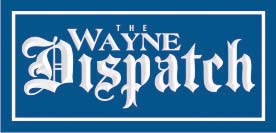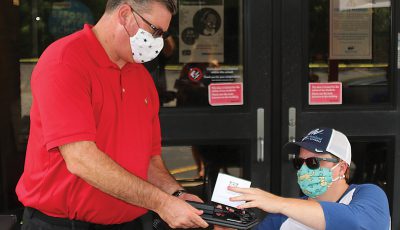State of the Wayne-Westland School District
By Carolyn Marnon – An overflow crowd had to settle into the John Glenn High School media center on April 11 to listen to Wayne Westland School District’s inaugural State of the District Address given by Superintendent Dr. Shelley Holt. Dr. Holt told the crowd gathered in the school’s auditorium that they had expected 15-30 people to show up. Over 400 people RSVP’d to the event and it appeared over 200 people had shown up that evening. The event was also being broadcast live on Facebook.
Dr. Holt has been the school district’s superintendent since last September. She has four children who are currently attending Wayne Westland schools. Mistress of Ceremonies Courtney Conover introduced Dr. Holt by saying she “created internal and external systems of communication to spread the good news of Wayne Westland and ensure we are all on the same page moving forward.” She also noted Dr. Holt “restructured the district to create the climate, culture and social emotional learning division to help improve the working conditions of all employees.”
“We embody the true passion of great futures…We are in the midst of starting right here a movement to make excellence the expectation here in Wayne Westland,” said Dr. Holt before sharing some of the district’s points of pride:
· Well-developed music programs
· Award winning JROTC program
· Alternative high school opportunities which have led to more than double the graduation rates in the last few years
· Online learning opportunities including dual enrollment, direct college, advanced placement and special services
· Transportation department that busses 7500 students daily
· Food services prepares 10,800 meals daily
· Newly restored planetarium at John Glenn
· Reigning Ethics Bowl champions for the state
· Varsity girls basketball at Wayne Memorial made it to the state quarterfinals
· Winter percussion team competed in the world championship
· Middle schools with award winning history presentations and students taking high school courses in middle school
· State coach of the year in wrestling at John Glenn and state coach of the year in varsity girls basketball at Wayne Memorial
“Excellence is the expectation here in Wayne Westland, and we will continue as such,” said Dr. Holt.
Several educational issues since 1998 were addressed. No Child Left Behind, which declared every child would be proficient by 2014, was passed. Students had been taking the MEAP in grades 3-8 and 11. Common Core Standards were adopted. Between 2009 and 2014, the economy was slowly coming back financially, but it wasn’t as good as it was in 2008. There became an expectation for safety and security as campus shootings started to become epidemic and were a source of anxiety. Educational testing targets were changing with the changes from MEAP to MSTEP and from ACT to SAT. It is difficult for educators to hit a target that keeps moving. Enrollment was steadily declining, like it is all over Michigan, due to declining birth rates and school of choice options. Free and reduced lunches are increasing at the schools. Did you know the largest family shelter in Michigan is in the boundaries of Wayne Westland?
Charts were presented showing how Wayne Westland was progressing compared to peer schools. WW is losing the most students to Garden City and Plymouth Canton while gaining students mostly from Inkster and Garden City.
There is a steady decrease in Caucasian students while the number of African-American students has stayed fairly level. Standardized tests in grades 3-8 have showed students underperforming compared to Peer Districts and has been in a steep decline since 2014. Dr. Holt said the deepest decline has been in mathematics.
While WW’s graduation rate was increasing from 2013-2016 to 76.6%, it then dropped to 72.9% in 2017. Peer districts graduation rates have been rising to approximately 81%. The dropout rate in WW was 13.1% in 2017 compared to peers with less than 8%. Both WW and the peer district’s dropout rates seem to be steadily declining.
WW received $11,150 per student in 2017 compared to approximately $11.600 for peer district students. However, revenue appears to be increasing for all.
General fund expenditures per student were $10,571 in WW vs. over $11,000 in peer districts.
Before 2016, WW had the highest general fund expenditures per full-time employee over peer districts. However, the expenditures have been declining since 2013 in WW while other peer districts have been increasing.
The student teacher ratio in 2017 in WW was 18.3. It was at a high of 19.6 in 2013 and 2014. Peer districts are at about 17.8 students per teacher.
Videos from several teachers were shown during the presentation. These teachers spoke of how Wayne Westland was the place to work 11 years ago and about how hard it was to get a job in the district. Now, they say, it is hard to keep teachers. Teachers are leaving for better jobs in other districts. There are frustrations because of the pay freeze. One teacher came to WW from a charter; she had to take an $8,000-10,000 pay cut to come here. In five years here, she has had three principals at her school.
Dr. Holt thanked Dr. Greg Baracy for his 17 years as superintendent. “I thank Dr. Baracy for doing his absolute best to set us up for success,” she said. “It is very easy to critique from the outside the decisions that are made, but I have to believe that everyone who sits in this seat is going to do what they believe is best for children.” She commended prior superintendent Dr. Michele Harmala for building bridges over the hurt, anger and lack of trust among all levels in the district.
The missing piece, Dr. Holt believes, is having a central office support system. Staff felt they weren’t getting the support they needed from central office. Central office thought they were doing all they could to help. As luck would have it, Rebecca Peck discovered that the University of Washington Center for Educational Leadership had a central office support framework that WW could adopt. As things are implemented, schools will be able to move forward with them. “I knew this was risky,” says Dr. Holt, but the teachers wanted support. The support will be tailored to meet the needs of the schools. Dr. Holt shared that the support structure that had been in place at WW was the same support as 20 years ago.
Five new departments were created. Business, Maintenance and Instructional Operations: If the heat goes out, the computers go down or pipes break, the school can’t function. Operations win out over instruction in these cases. “We have never shut down school because of a math lesson gone wrong,” joked Dr. Holt. She said all testing is now online so wifi is needed.
Employee, Community and Government Relations (formerly known as HR-Human Resources): WW has had only one family resource person for the entire district and she worked out of one school. That has now been increased to five resource persons spread out among multiple schools. It is also hoped that the district will be able to bring back parent liaisons to help the teachers.
Professional Learning and Accountability: There are many new teachers and administrators in the district. Employees at all levels need to be developed.
Climate, Culture and Social Emotional Learning: The climate and culture of the district has been a source of consternation for some time, according to Dr. Holt. The district hopes to move the behavioral dial by focusing on five core competencies in social emotional learning: self-awareness, self-management, social awareness, relationship skills and good decision-making.
The fifth department is Standards, Learning and Innovation.
Dr. Holt encouraged people to join any of the advisory committees that they are setting up. For more information, contact the school district. Excellence is the expectation.











